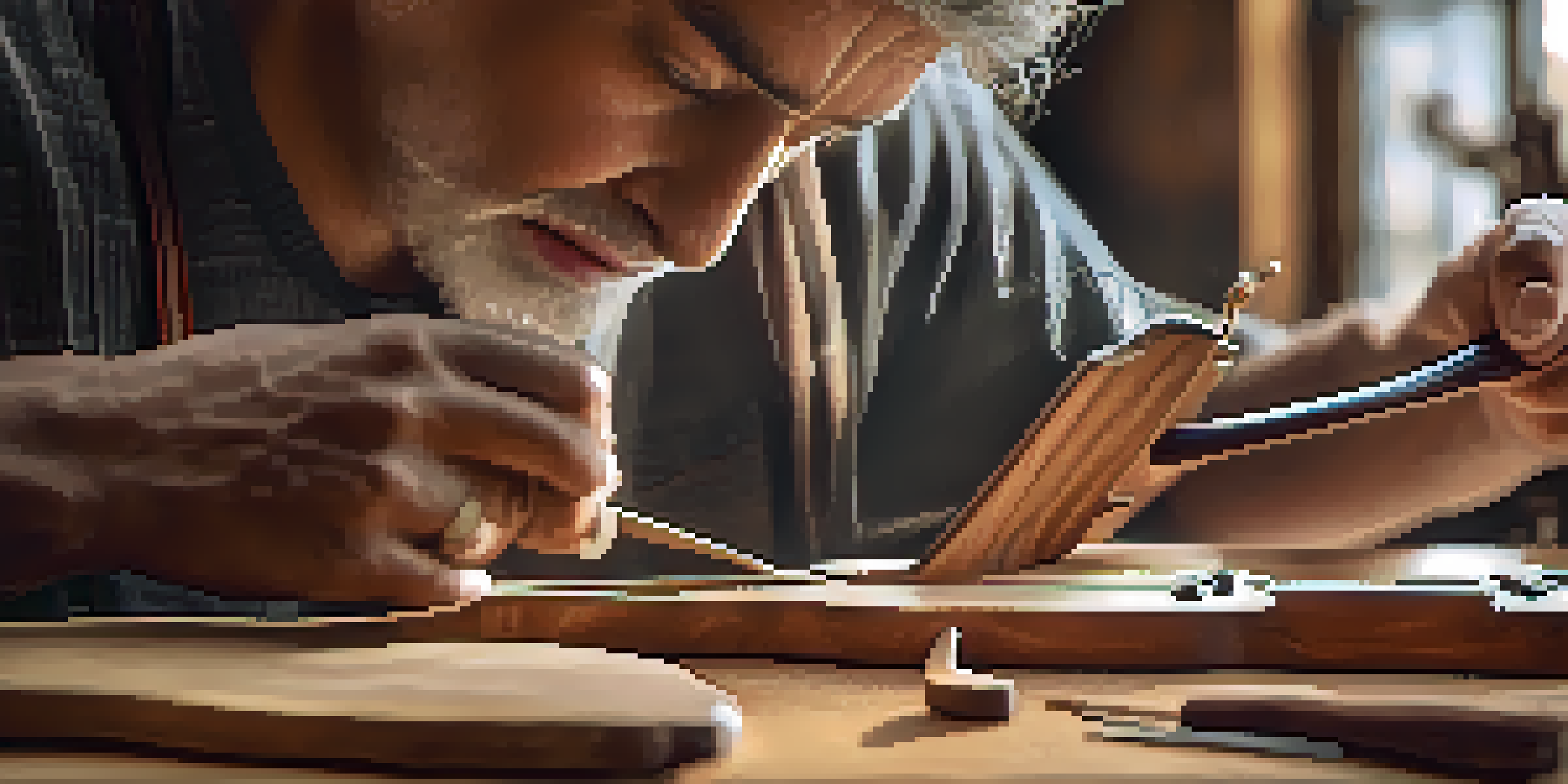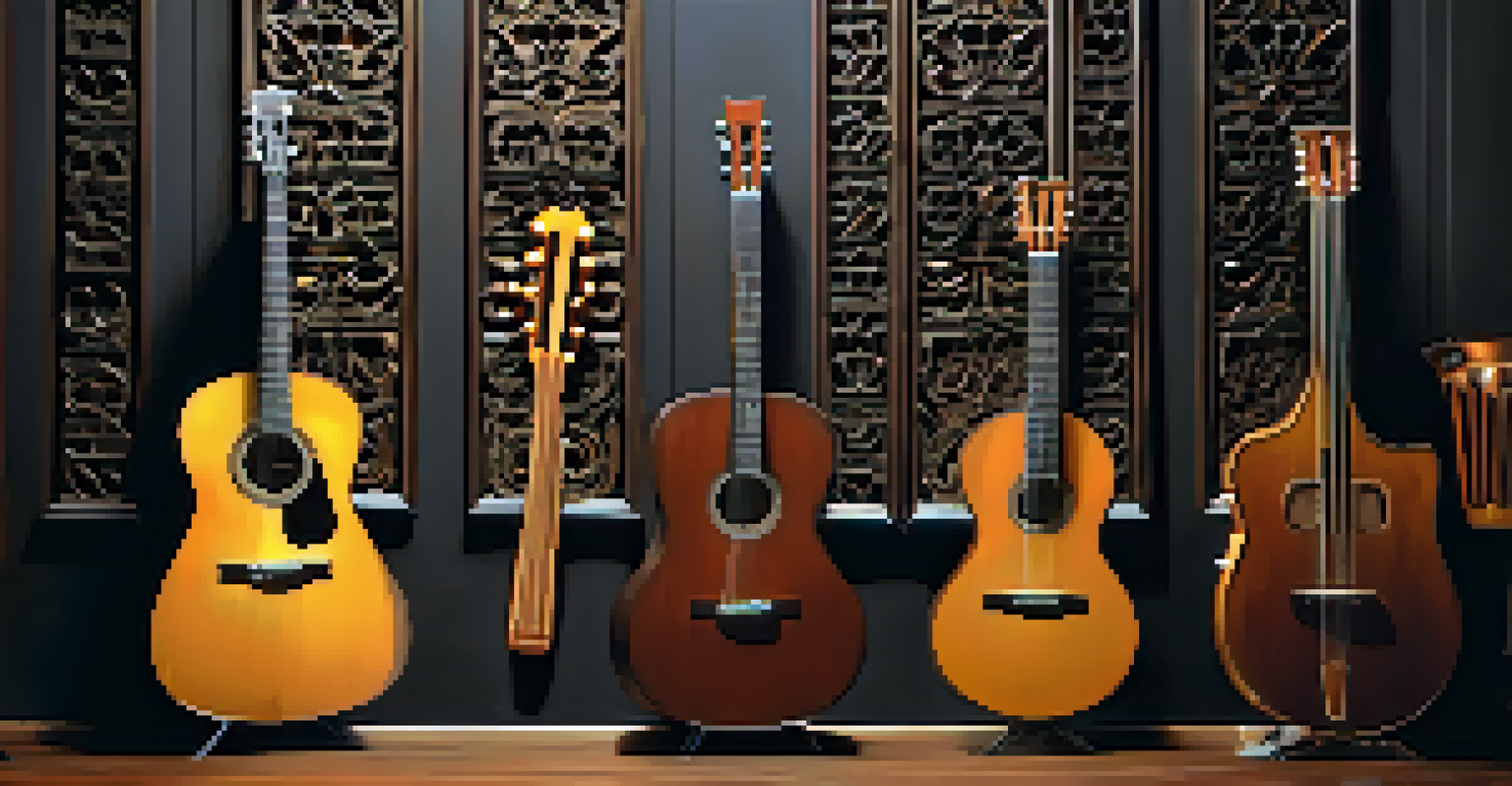Carving and Sound: How Artistry Influences Musical Quality

The Connection Between Carving and Sound Quality
When it comes to musical instruments, the way they are carved can significantly affect their sound quality. Each curve and contour plays a role in how sound waves resonate, ultimately influencing the tone produced. For example, a finely carved violin will produce a richer, more vibrant sound compared to one that is poorly crafted.
The beauty of music is that it connects us all, and the artistry behind the instruments we play enhances that connection.
Artistry in carving isn't just about aesthetics; it's about functionality. Skilled artisans understand the science behind sound production and use their expertise to enhance the instrument's acoustic properties. This delicate balance between art and science is what sets high-quality instruments apart from the rest.
Moreover, the materials used in carving also contribute to the overall sound. Different woods and finishes can create unique sound profiles, showcasing the importance of thoughtful selection in the crafting process. Ultimately, the artistry involved in carving is a crucial factor in determining the musical quality of an instrument.
Historical Perspectives on Carving Techniques
The art of carving musical instruments has a rich history that dates back centuries. Traditional methods, often passed down through generations, play a crucial role in shaping the sound of instruments. For instance, the meticulous carving of a lute or a cello has evolved into an art form that blends cultural heritage with modern techniques.

In many cultures, specific carving styles are associated with particular sounds and musical genres. For example, the intricate carvings found on African drums are not only visually stunning but also enhance their unique rhythmic qualities. This shows how artistry can be deeply intertwined with cultural identity and musical expression.
Carving Shapes Instrument Sound
The contours and curves of an instrument play a crucial role in determining its sound quality.
As we explore these historical perspectives, it's clear that the techniques used in carving have been influenced by both necessity and creativity. Carvers have continually adapted their methods to improve sound quality while maintaining the aesthetic beauty of the instruments they create.
The Role of Materials in Sound Production
The type of material used in carving can dramatically alter the sound an instrument produces. For instance, hardwoods like maple or mahogany are often favored for their density and ability to create a warm, resonant tone. In contrast, softer woods might be chosen for their lighter sound, offering a different musical experience.
Art is not what you see, but what you make others see. In the world of music, the carving of an instrument is an extension of this idea, shaping not only sound but emotion.
Additionally, various finishes applied to the wood can either enhance or dampen sound. A well-oiled finish can promote resonance, while a heavy lacquer might mute certain frequencies. Understanding how materials interact with sound waves is essential for artisans aiming to create high-quality instruments.
Choosing the right combination of wood and finish not only affects sound quality but also the instrument's longevity. A thoughtful approach to material selection ensures that the artistry of carving translates into a product that resonates beautifully for years to come.
Artistry in Modern Instrument Making
While traditional carving techniques remain vital, modern instrument makers are increasingly incorporating technology into their artistry. Computer-aided design (CAD) allows for precision that was previously unattainable, ensuring each instrument is crafted to exact specifications. This blend of artistry and technology has opened new avenues for sound quality.
However, the human touch in carving is irreplaceable. Many artisans still prefer hand-carving, believing it imbues each instrument with character and soul. The artistry involved in hand-crafting instruments creates a unique bond between the maker and the final product, influencing the sound in ways that machines simply cannot replicate.
Materials Affect Sound Production
The choice of wood and finishes in carving significantly influences the tonal qualities of musical instruments.
As we look at modern practices, it’s clear that the heart of artistry remains in the hands of skilled craftsmen. The ongoing dialogue between tradition and innovation continues to shape the future of musical instruments, ensuring that sound quality remains at the forefront of design.
The Influence of Carving Style on Instrument Sound
Different carving styles can impart distinct qualities to the sound of an instrument. For instance, ornate carvings may enhance the visual appeal but can also affect the way sound waves travel through the material. This interplay between style and sound demonstrates the importance of thoughtful design choices.
Consider the contrast between a sleek, minimalist design versus one filled with intricate carvings. While both can produce beautiful music, their tonal qualities might vary significantly. A minimalist approach often promotes clarity and projection, while ornate styles might offer warmth and depth.
Ultimately, the influence of carving style on sound is a fascinating aspect of instrument making. Musicians often choose their instruments based not only on appearance but also on the unique sound that different carving styles can produce, showcasing the artistry's impact on musical expression.
The Emotional Connection Between Music and Artistry
Music is a deeply emotional experience, and the artistry behind an instrument can amplify that connection. When a musician plays an instrument crafted with care, the emotional depth of the performance can resonate with the audience in profound ways. This emotional impact is often rooted in the artistry involved in the instrument’s creation.
For many musicians, the relationship with their instrument is akin to a partnership. The time spent selecting, playing, and nurturing the instrument can create a bond that enhances their musical expression. This connection is often intensified when the instrument has been crafted by a skilled artisan who understands the nuances of sound.
Tradition Meets Modern Innovation
The blending of traditional carving techniques with modern technology is reshaping the future of musical instruments.
When artistry meets music, the results can be magical. Instruments that are not only well-crafted but also resonate emotionally can elevate performances, creating unforgettable moments for both musicians and listeners alike.
Future Trends in Carving and Instrument Design
As we look to the future, the field of carving and instrument design is poised for exciting developments. Innovations in materials and techniques are likely to change how instruments are crafted and perceived. For example, sustainable materials are becoming increasingly popular, offering both environmental benefits and unique sound qualities.
Additionally, the fusion of traditional craftsmanship with modern technology will continue to push boundaries. Artisans may explore new methods of sound enhancement, blending age-old techniques with contemporary insights to create instruments that are both beautiful and musically rich.

Ultimately, the future of carving and sound promises to be a collaborative journey between tradition and innovation. As artists and musicians work together to explore new possibilities, we can expect to see an evolution in the artistry and quality of musical instruments that continues to inspire.